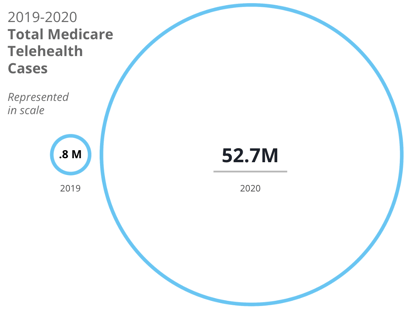Is Your Hospital Ready for a Second Opinion Program?


Demand for telehealth solutions has boomed over the past few years. Medicare telehealth visits alone grew from 840,000 in 2019 to 52.7 million in 2020, or 63-fold as shown right (source: Benesch Friedlander Coplan & Aronoff).
For cases deemed appropriate for telehealth, some studies have provided overwhelming evidence of increased patient satisfaction with remote visits compared to traditional in-person (urology; breast cancer; radiation oncology; general medicine). One of the main drivers? Convenience. Patients love removing the travel time and associated costs or tradeoffs that come with taking off work, finding childcare, and traveling to see a physician in person. Additionally, the CDC reports that 15%, or 49.8 million Americans live in rural parts of the U.S., which correlates with poorer health outcomes regardless of income level. Access to specialty care for this population has been known to be especially difficult or impossible, but telehealth programs have introduced a new channel that many patients can take advantage of.
In addition to increasing patient demand, there is a strong business case for Hospitals to expand their reach through telehealth modalities. A recent article by Purview's Dr. Christopher Schwartz, Remote Second Opinions: A Cure for the C-Suite Blues, describes the challenging financial state of many hospitals post-covid. Schwartz explains that, ‘during the lockdown alone, U.S. hospitals lost an estimated $22 billion in revenue due to cancellations in elective surgeries.’ Contrast this with the estimated value and market growth of the second opinion market at $10.7 billion by 2027 with a CAGR 16.8%, and it is understandable why many hospitals are exploring the potential of these programs. Here, we outline key considerations for your organization as you assess readiness prior to launching a second opinion program.
Opportunities & Benefits for Providers
Second opinion programs present an opportunity to promote your existing expertise and where appropriate to convert consultations into inpatient procedures. Revenue alone from second opinions should not be your goal. Done well, hospitals can expect to break even and have the program fund itself. However, second opinion programs can be a pathway to other direct and indirect benefits for the healthcare organization.
Improve Patient OutcomesA second opinion consult from a specialist can change the course of a patient’s health journey. In fact, a recent study by the Mayo Clinic considering a range of diseases found that 88 percent of original diagnoses were changed or refined because of a second opinion.
Extend Your Brand
Second opinion programs allow hospitals to extend their brand by informing patients beyond their local geography.
Attract Top Doctors
Second opinion programs can make your organization more attractive to top specialists whose practice (and potential pocketbook) can be enhanced and expanded by the extended audience an online second opinion may provide.
Build Your Reputation
By promoting your expertise through a second opinion program, your facility will be able to stand out from the crowd.
Assessing Readiness
Almost any hospital can benefit from establishing a second opinion program. However, the success of a program requires a willingness to make some tough choices and focused actions.
Figure Out What You Are Really Good At
When implementing a second opinion program, the best place to start is with a specialization that you are already good at. For some hospitals, this is obvious. For others, it might be worth surveying your patients. It’s generally best to focus tightly on one or a small number of divisions or sub-specialties.
Get Physician and Staff Buy-In
The success of any second opinion program relies on your physicians. So as you start planning your program, it’s essential to get your providers on board from the beginning. Make sure you answer their questions, address their concerns, and take their perspectives into account as you start planning. Understand and communicate “what’s in it for them,” to ensure you get their momentum behind you. This may require offering stipends to the physicians who write these opinions.
Assess Competitive Environment and Geography
Second opinion programs are just starting to pop up in more places. So while second opinion programs can indeed increase your geographic reach, one of your competitor’s second opinion programs may intrude on your local turf. Establishing a program early can be a good defense against losing market share as well as a good offense for gaining market share.
Understand Interstate Licensure
Licensure is tricky. Unless you are willing to create clear processes and enforce strict practices, you may find yourself and your doctors running afoul of regulations. You will need to engage your legal team early to ensure you remain in compliance.
Commit to a Marketing Plan
Patients won’t use your second opinion program if they don’t know about it. As you’re getting started, bring your marketing team into the conversation early. A remote second opinion program can differentiate your brand – especially for a specialty or sub-specialty you’re already known for. Working with your marketing team to clarify your message, develop content, and identify the most effective channels for reaching patients and promoting your program is a basic requirement of any successful program.
Want to learn more?
Check out Purview's Remote Second Opinion Maturity Model
![]() Listen to Purview's Webinar
Listen to Purview's Webinar
Delivering the Future of Healthcare - Do Remote Second Opinions Open New Doors?



